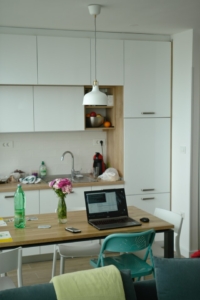Organizational culture change is a big topic. I usually work with organizations that want to change their culture. Like the professional services company that used a physical move as the catalyst toward a more team-based, collaborative, and cross-functional culture.
There is another aspect of culture that doesn’t get much attention—what do you do to maintain culture? That was a question a senior executive in a major law firm asked when we were talking about leading and managing in a virtual environment.
His firm had worked very hard to create the desired culture. A culture that made his firm a great place to work and very successful. He was concerned with people working remotely, the stress of the uncertainty, and the requirement for maintaining physical distance they risked losing key elements of their culture.
Culture is Stable But not Static
It’s easy to overlook the impact of your organization’s culture when it’s working and leading to success. The good news is for most organizations their culture, for better or worse, is stable which makes culture difficult to change. The bad news is it’s not static. Strong external or internal forces will shift a culture. 
The pandemic and the required shift to working remotely could be a strong enough external force to shift a culture that was highly successful and desired in the physical environment. With little time to prepare, leaders, managers, employees are faced with having to work remotely. Teams and colleagues who had socialized, collaborated, and shared stories easily and spontaneously are now physically disconnected from each other. Without the structure and routine of the physical environment some employees struggle and feel isolated as they try to navigate remote work.
Initially it was just for a few weeks. In those early weeks we were all in survival mode, just get in and set up virtual and remote working so we could keep working and serving our customers and clients. Now, as the weeks have stretched into months you may be seeing the impact on your organizational culture.
Culture is the Engine that Runs Your Organization
Before we talk about what’s needed to maintain culture it’s helpful to understand what culture is and why it matters to your organization.
Your organizational culture is the engine that runs your organization. Culture is the collectively held beliefs, learned values, and assumptions that guide and direct individual behaviours and interactions. Your culture defines how, what, and why things get done the way they do in your organization.
What makes culture so powerful is that it holds both our conscious and unconscious beliefs, habits, and attitudes. That’s why you can train people to do something different, but if you don’t address the underlying beliefs your culture won’t change and the newly acquired skill or activity doesn’t stick.
Three Actions to Help You Maintain Your Organizational Culture in a Virtual Environment
To maintain your organizational culture, you need three things. First an understanding of the elements that define, create, and maintain a culture. Second, you need to assess and explore the way these elements have created and shaped your culture. Finally, you need to take thoughtful and deliberate actions to continue to shape and maintain your organizational culture.
Edgar Schein, professor emeritus at MIT, identified three levels to corporate culture, the artifacts, the espoused values, and the underlying assumptions. Each level is less visible and exerts a greater force on your organization’s culture than its predecessor.
Maintaining your organizational culture in a virtual environment will require you to understand the impact each level has on your culture and then work within each cultural level to create or maintain the elements to support the desired culture.
- Identify the artifacts that existed within your physical environment and explore how they contribute to your organization’s current culture.
The artifacts of an organization’s culture are those elements within your organization that make your culture visible. They are the easiest to identify and tend to be the things people think about when they think of culture. For example, your office décor, the physical layout of the office i.e., do you have open cubicles or offices, the way you greet and interact with people, and even how work is assigned. 
In one organization where I worked everyone arrived early and we tended to congregate around the reception desk. We socialized, talked about what was on our plate, and then proceeded to our offices. If you had asked me at the time about the culture of that organization I would have said it’s friendly, collaborative, and a sense of family. And I would have described these morning gatherings as evidence of that culture.
What are the visible elements in your physical environment that demonstrate and support your culture?
What is needed to recreate a similar artifact to support and maintain your culture in the virtual world?
- Review the structures, processes, and other ways your organization demonstrates and lives its espoused values, philosophies, and strategy in your physical environment.
Your espoused values are less visible than the artifacts but exert a more powerful influence on your culture. They are the values, philosophies, and commitments members of the organization talk about. This element of your culture defines why you do the things you do and why some of the cultural artifacts exist. For example, your values statement, vision and mission statements, strategies, and any customer or client services promises and policies.
 When I think about the organization I mentioned earlier I recall that two of its core values were collaboration and innovation. Throughout the office were reminders of teamwork, the office was organized in a series of pods, members from other departments were frequently and sometimes spontaneously brought in to brainstorm a problem, and those informal morning conversations at the reception desk were encouraged. It wasn’t unusual for the CEO and other members of the senior leadership team to participate in those morning conversations. It also wasn’t unusual for the conversation to extend into a meeting room with a whiteboard where a seed of an idea or possible solution to a problem would be further explored.
When I think about the organization I mentioned earlier I recall that two of its core values were collaboration and innovation. Throughout the office were reminders of teamwork, the office was organized in a series of pods, members from other departments were frequently and sometimes spontaneously brought in to brainstorm a problem, and those informal morning conversations at the reception desk were encouraged. It wasn’t unusual for the CEO and other members of the senior leadership team to participate in those morning conversations. It also wasn’t unusual for the conversation to extend into a meeting room with a whiteboard where a seed of an idea or possible solution to a problem would be further explored.
How do the values espoused by your organization, and its members manifest themselves in your physical environment?
What will be needed to carry and support those values in the virtual environment?
- Ask questions to uncover the hidden and unconscious beliefs and assumptions that form the unspoken rules of your organization.
The foundation for every other aspect of your culture is the unconscious and collectively learned beliefs, the assumptions members make, and the individual or group habits practiced throughout the organization. They are the essence of your culture and are the most powerful driver of what happens in your organization. These unspoken and largely unconscious elements can override the other two aspects of your culture.
Because this third element of culture is usually unconscious and always unspoken they are difficult to uncover. They can reveal themselves in the stories and conversations people share and the history that is passed down to new members of the organization. For example, members may have an unconscious belief that remote workers aren’t as productive. Virtual work has had mixed reactions and some organizations prior to Covid-19 had strict no remote work policies.
What are the assumptions, learned beliefs, stories, and unwritten rules that have made your culture successful in the physical environment?
How have they influenced the other elements of your culture e.g., artifacts and espoused values?
What is needed to increase or decrease their impact to maintain your culture in the virtual environment?
Maintaining or changing your organizational culture requires you to recognize the unspoken and unwritten beliefs, patterns of activities, relationships, and artifacts that have enabled and supported your culture. Making time to reflect and understand what makes your current culture successful will enable you to identify and take action to recreate the conditions needed to maintain it in the virtual environment.



